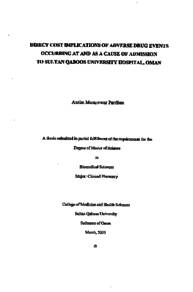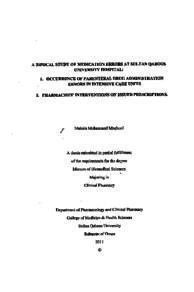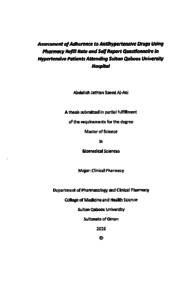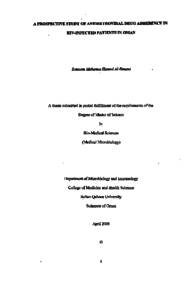Document
Direct cost implications of adverse drug events occuring at and as a cause of admission to Sultan Qaboos University Hospital, Oman
Publisher
Sultan Qaboos University
Gregorian
2005
Language
English
Subject
English abstract
Introduction: Adverse drug events (ADEs) are injuries resulting from medical interventions related to drugs including their non-use. The occurrence of ADEs causes considerable negative impact, not only on the health of the population but also on healthcare costs. ADEs are estimated to injure over a million hospitalized patients each year and cause approximately 180,000 deaths annually in the United States (U.S.) alone. Consequently the economic burden of drug-related morbidity and mortality in the U.S. was estimated to exceed U.$. dollars (USD) 177.4 billion in the year 2000. It can be reasonably assumed that the picture is no different in other parts of the world. Prevention of ADEs has immense potential for improved medical care and cost savings since 28 80% of the ADEs are potentially preventable. An assessment of the direct cost of managing ADEs resulting in admission to or occurring in wards of Sultan Qaboos University Hospital (SQUH) is yet to be conducted. Aim: To assess the direct cost implications of ADEs resulting in admission to or occurring in wards of SQUH. Method: The prospective observational study was conducted over a period of 3 months
from November 1, 2003 until January 31, 2004. All patients admitted to SQUH wards. except those with voluntary drug overdoses and accidental poisonings were included in the study. Case finding was done by using a combination of voluntary reporting, computerized monitoring, chart review and patient interview techniques. Each ADE was assessed for probability of causality, its nature (fugitive/non-fugitive), preventability and, direct cost (including length of hospital stay) involved in its management. The physician's judgement was used to assess for any additional length of hospital stay induced by an ADE occurring in the wards. All data were entered into a computerized database created by using Statistical Package of Social Sciences (SPSS) version 10 for Windows. Chi-square test, Mann-Whitney U and Kruskal-Wallis H tests for statistical significance were applied wherever appropriate. Results: From a total of 4,327 admissions during the study period, 203 ADEs were found to have occurred in 110 patients. Seventy-four ADEs triggered hospital admissions and 129 occurred in hospitalized patients. Males appeared to be at a higher risk of experiencing ADEs as compared to females. Geriatric patients were more vulnerable to risk of experiencing ADEs especially those arising due to noncompliance to cardiovascular agents. The number of fugitive ADEs was very high with the voluntary reporting method identifying only 8% of all ADEs detected in this study. More than 40% of the ADEs detected in this study were preventable. Amongst these a majority (73.8%) were triggered by medication noncompliance. A total direct cost of Rials Omani (RO) 152,739.860 (= USD 397,123.64) was involved in managing all ADEs identified in this study, of which RO 100,182.100 (- USD 260,473.46) was spent on managing preventable ADES. Medication noncompliance was responsible for 88.6% (RO 88,753.842 - USD 230,759.99) of the total amount spent on managing preventable ADEs. The cost of managing ADEs triggering hospitalization was significantly higher than that involved in managing ADEs occurring in the hospital. A total of 1,106 days of hospital stay was attributable to ADES. Conclusions: Adverse drug events are undesirable - both from the point of view of patient care and the resources utilized in their management. Averting the occurrence of preventable ADEs would have resulted in substantial cost-savings to the hospital. Proactive measures need to be adopted to curb the occurrence of medication noncompliance - a problem that has enormous potential for improving both the patient's health as well as effective utilization of resources in the hospital.
Description
Thesis
Member of
Resource URL
Arabic abstract
المقدمة: الآثار الجانبية للحواء هي إصابات تنشأ عن التدخلات الطبية المتعلقة باستخدام او علم استخدام الأدوية . قد تتسبب هذه الآثار الجانبية في إحداث تأثيرات سلبية كبيرة ليس على صحة الأفراد فقط ولكن على تكاليف الرعاية الصحية أيضا. في الولايات المتحدة وحدها يقدر عدد المرضى في المستشفيات الذين أصيبوا بالآثار الجانبية للأدوية بما يزيد عن مليون مريض سنويا ,كما بلغ عدد الوفيات بسبب هذه الآثار الجانبية قرابة 180 ألف حالة وفاة. لقد قدر حجم الأعباء الاقتصادية الناتجة عن الإصابات أو الوفيات بسبب الآثار الجانبية الأدوية بما يزيد عن 177 . 4 مليار دولار امريكي في عام 2000 ومن الممكن الافتراض بان الصورة في المناطق الأخرى من العالم لا تختلف عما هي عليه في الولايات المتحدة. إن منع حدوث هذه الآثار الجانبية يمكن أن يؤدي إلى تحسين الرعاية الصحية و إلى تقليل النفقات استنادا إلى أن 28-80% من الآثار الجانبية هي آثار قابله للمنع حتى الآن لم يتم تقدير التكلفة المباشرة لمعالجة الآثار الجانبية للأدوية المتسببة في إدخال المصابين إلى مستشفى جامعة السلطان قابوس أو تلك التي تحدث داخل اجنحة مستشفى جامعة السلطان قابوس. الهدف: تقييم أثر التكاليف المباشرة للأعراض الجانبية للأدوية المؤدية لدخول مستشفى جامعة السلطان قابوس أو تلك التي تحدث داخل اجنحة المستشفى . الطريقة: دراسة مستقبلية بالملاحظة أجريت على مدى ثلاثة اشهر من 1 نوفمبر 2003 إلى 31 يناير 2004. لقد شملت الدراسة جميع المرضى الذين اخلوا لأجنحة مستشفى جامعة السلطان قابوس إضافة إلى أولئك الذين تعمدوا اخذ جرعات زائدة من الأدوية أو الذين تعرضوا للتسمم بطريقة غير مقصودة. لقد تم التعرف على الحالات بعدة وسائل منها البلاغات الطوعية, التقييم عن طريق الحاسوب مراجعة وصفات الأدوية و تقنية المقابلة المباشرة مع المرضى. لقد تم تقييم كل اثر جانبي على حدة من حيث ارتباطه باستخدام/عدم استخدام الدواء, علم الإبلاغ عنه , إمكانية منع حدوثه و التكلفة المباشرة لعلاجه (التي تشمل تكلفة مدة البقاء داخل المستشفي ايضا. لقد تم الاعتماد على حكم الأطباء لتقييم ما إذا كان طول مدة البقاء داخل المستشفى هي بسبب الآثار الجانبية للأدوية التي تحدث داخل أجنحة المستشفى . تم إدخال كل المعلومات في قاعدة معلومات حاسوبية تم إنشاؤها باستخدام نظام التحليل الإحصائي (SPSS). لقد تم استخدام كل من اختبار
Category
Theses and Dissertations




